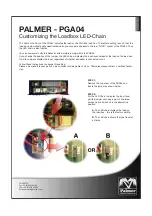
5.4.2.4
Absolute encoder AE-S64-SinCos-07-AE
Wire-end sleeves
Function
Designation
Grey
C+
Commutation signal (cosine)
Pink
C-
Commutation signal inverse (inverse cosine)
Black
D+
Commutation signal (sine)
Brown
VCC
Voltage 5 V DC
White
GND
Power supply ground
Blue
B+
Analog track B (sine)
Violet
D-
Commutation signal inverse (inverse sine)
Grey/pink
Z+
Reference signal
Red/blue
Z-
Reference signal inverse
Green
A+
Analog track A (cosine)
Yellow
A-
Analog track A invers (cosine invers)
Red
B-
Analog track B invers (sine invers)
Table 5-4-2-4
5.4.3
O
ff
set
"
"
Unless otherwise agreed, the absolute encoder o
ff
set is set to 0. This is achieved by connecting
DC voltage with
U to +
and
V and W to -
.
"
"
The absolute encoder may not be mechanically detached to ensure that the factory settings are not
lost. If the absolute encoder has been detached, a new absolute value encoder calibration must be
performed with the frequency inverter. For details of the procedure, refer to the frequency inverter
operating instructions.
5.5
Brake
3 x Brake type ROBA
®
-diskstop
®
, RSD9, 3 x 3062 Nm
•
Also refer to the operating instructions for the brake.
5.5.1
Scope of application
•
The brakes are intended for static applications as holding brakes. Dynamic braking must be
restricted to emergency and inspection braking. No wear occurs on a holding brake. This means
that the brake is maintenance free, and only the air gap has to be checked as described in the
“
Maintenance and repair - Inspection intervals - Checking the air gap
”
chapter.
5.5.2
Mechanical releasing
Mechanical bleeding of the brakes is possible if the optionally available Bowden cable system (article
number 70031122) is used.
The Bowden cable system can be retro
fi
tted. The brakes always have the lever for hand release for
the Bowden cable system.
The mechanical hand release system actuates all three brake circuits simultaneously. For the
test case "failure of a brake circuit", the brake circuits can be disengaged separately using the
lever for hand release and only one brake circuit can be mechanically kept open, for example.
5.5.3
Release monitoring
•
The brake release monitoring serves as monitoring for redundancy and the operation status of the
brakes.
•
The release monitoring of the brakes must be evaluated, otherwise the type examination will
not be ful
fi
lled! The change of state of the three brake circuits must be monitored separately.
•
Release monitoring of the brakes is carried out using inductive proximity switches. For technical
data, see chapter "Appendix - Technical data - inductive proximity switch".
Original operating instructions
ZAtop
–
model series SM315.100A
Electrical installation
A-TBA22_02-GB 2022/50 Index 002 Part.-No. 01013486-GB (EU-BD 1075)
21/76
















































